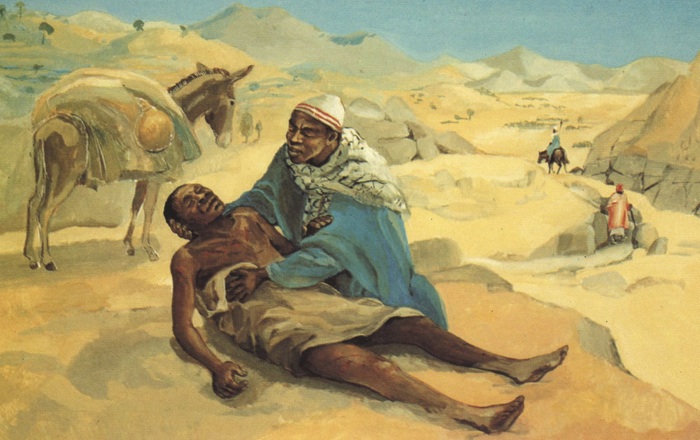Commentary on Amos 7:7-17
Amos 7:7-17 describes two episodes in the prophetic career of Amos, set in the northern kingdom of Israel around 750 BCE.
Verses 7-9 recount a vision of doom for Israel that he received. Verses 10-17 describe his encounter with the priest Amaziah, which results in Amos’ being banned from the temple at Bethel. These originally separate episodes are connected by their similar announcements of judgment against King Jeroboam II of Israel (vv. 9, 11). Although their tone is largely negative, they are not completely without hope, and they offer contemporary readers an opportunity for critical self-reflection.
The vision
The phrase “vision” may bring to mind the elaborate, bizarre imagery associated with Ezekiel or Revelation. Many prophetic visions in the Bible, however, are simple object lessons. (Imagine a really ominous children’s moment!) The prophet sees a single object or scene, which is either self-explanatory or comes with a brief explanation.
Unfortunately, it is not clear what Amos sees in Amos 7:7-9, because the text includes an obscure Hebrew word in vv. 7-8. Most English translations of the Bible, including the NRSV, translate it as “plumb line,” but the word may mean “tin” or “plaster” instead.1 Whatever it means, the significance is clear. God will no longer overlook the failures of the people of Israel, described primarily in the book of Amos as economic oppression (Amos 2:6-7; 5:10-12; 8:4-6). Following each of his previous visions (Amos 7:1-6), the prophet had persuaded God to give the people another chance. Now, punishment has become inescapable. A violent catastrophe — likely a military invasion — lies in Israel’s future, with disastrous implications for its religious sanctuaries and ruling dynasty (v. 9). It is significant, though, that God still calls Israel “my people” in v. 8. This detail offers a brief glimmer of hope, suggesting that restoration may be possible on the other side of judgment.
The encounter with Amaziah
Bethel was the site of an ancient religious shrine (see Genesis 28:18-19) that became the chief sanctuary of the kingdom of Israel (1 Kings 12:28-33). Amos had proclaimed that the worship-taking place there was meaningless because it was divorced from a concern for economic justice, especially for Israel’s oppressed agricultural laborers (Amos 5:21-24). He even warned of Bethel’s destruction (Amos 3:14, 5:5-6). Not surprisingly, these words attract the attention of Amaziah, a priest there. He perceives Amos as a threat not only to the temple at Bethel but to the stability of the nation, because the prophet had threatened the king. These fears were not groundless; prophetic activity had played a role in political uprisings in Israel before (see 1 Kings 11:29-39; 2 Kings 9:1-10). In response, Amaziah first sends a letter to King Jeroboam reporting Amos’ role in a possible conspiracy (Amos 7:10-11). This action would not have been unusual, as royal officials (including priests) frequently reported prophetic activity to rulers in the ancient Near East.2 Amaziah also forbids Amos from ever speaking at Bethel again. In the process, he makes it clear that Bethel is committed to the interests of the state: “it is the king’s sanctuary, and … a temple of the kingdom” (Amos 7:13 NRSV). He attempts to discredit Amos in v. 12 by dismissing him as an outsider and implying that he only prophesies for income. (Although he prophesied in Israel, Amos was a citizen of the neighboring kingdom of Judah.)
Ironically, Amos defends his prophetic activity by denying that he is a professional prophet. The phrase “prophet’s son” in v. 14 doesn’t necessarily refer to biological descent from a prophet, but rather to membership in a prophetic guild. Candidates for public office use similar rhetoric when they claim not to be career politicians or members of “the establishment.” He warns that neither Amaziah nor his family will escape the coming disaster that God has decreed for Israel (vv. 16-17). The story ends there, without revealing what happened to either Amaziah or Amos. King Jeroboam himself died peacefully, but his son was assassinated, triggering several decades of political instability for Israel (2 Kings 15:8-31). The kingdom was eventually conquered by the Assyrians in 722 BCE, and many of its citizens were exiled. The original audience of Amos 7, which was written after the time of the historical prophet, would have likely made these retrospective connections.
It’s easy to cast Amaziah as the villain in this story, but closer examination reveals a more sympathetic character. No doubt he sincerely believed he was doing God’s will by supporting the ruling powers. As current trends lead many to despair about the future of the church in America, one can even admire his commitment to the security of the institution he served. Faithful leadership frequently requires Amaziah’s brand of pragmatism. And yet his investment in the status quo ultimately led him to oppose God’s transformative work in the world. This unfortunate example should force us to examine our own individual and communal commitments. Whose interests do we promote? Does working with political and economic institutions — which no doubt accomplish much good — give our tacit approval to their unjust actions or policies? Can we simultaneously benefit from and speak out against structures that promote violence, enshrine economic oppression, and dehumanize persons of color, women, and sexual minorities? These are complex questions, and the answers may look very different in different contexts. This story invites us to self-reflection and criticism, lest we too sacrifice our witness to secure our survival.
Notes:
1 See Marvin A. Sweeney, The Twelve Prophets, Berit Olam (Collegeville, MN: Liturgical Press, 2000), 1:53-55; Shalom M. Paul, Amos, Heremeneia (Minneapolis: Fortress Press, 1991), 233-36.
2 J. Blake Couey, “Amos vii 10-17 and Royal Attitudes toward Prophecy in the Ancient Near East,” Vetus Testamentum 58 (2008): 310-13.


July 10, 2016